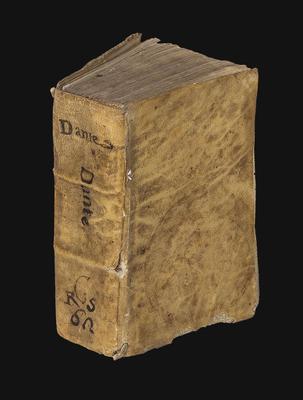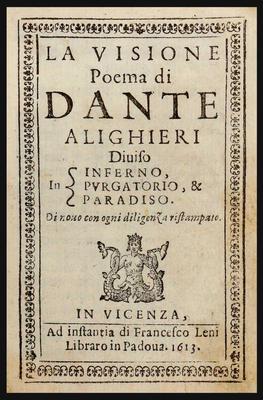Dante Alighieri
La Visione. Poema di Dante Alighieri Diuiso In Inferno, Purgatorio, & Paradiso. Di nouo con ogni diligenza ristampato.
Vicenza, Francesco Leni, 1613.16° (105x72 mm). Collation: A-Z8, Aa-Rr8. 608, [32] pages. Roman and italic type. Title-page within a woodcut border; woodcut printer's device on the title-page. Woodcut headpieces introducing each cantica, and the final tables. Contemporary limp vellum. Smooth spine with Dante's name inked both horizontally and vertically in an early hand, at the bottom a shelfmark ‘G.R 5 [?] 62', written in brown ink. A beautiful and unsophisticated copy; browning in places, slight wear to the outer lower corner of fol. L8, with loss of a few letters on the verso. The last quire resewn.
Provenance: Livio Ambrogio collection.
The first of only three editions of the Commedia published in the seventeenth century, and of the greatest rarity, presented here in its original vellum binding. The small volume is dedicated by the printer Francesco Leni to Giovanni Battista Minardi, whom he describes as a lover of poetry. The plainness of the 1613 edition of the Commedia, without any commentary – apart from the final tables of the capitoli and the argomenti, containing summaries of the content of each canto – or encomiastic texts or woodcuts reflects Dante's unpopularity in the Mannerist and Baroque period. Stylistically Dante was regarded as too archaic or old-fashioned and the medieval roots of his poetry were considered to be irremediable obstacles to its appreciation. Moreover, as the result of some controversial terzine on both the doctrine and the hierarchy of the Roman Church, in 1612 Dante's poem was included in the Spanish Index published by the Grand Inquisitor Bernardo de Sandoval y Rojas, and two years later in the Index issued in Venice, with the injunction that the incriminating verses – mainly concerning simoniac popes, and other vices of the ecclesiastical hierarchy – had to be expurgated.
For the first time in this Vicenza edition Dante's poem appears under the different title of La Visione, focusing on the mystical aspects of his journey through Hell, Purgatory and Paradise, a spiritual itinerary in quest of the vision of supreme Truth and Beauty, embodied by the beloved Beatrice. The new title, reflecting the Counter-Reformation reading of Dante, was also adopted for the second edition of the Commedia which appeared in the seventeenth century, the one published in 1629 by the Paduan printer Donato Pasquardi, whereas in the third edition, which likewise appeared in 1629 from the Venetian press of Niccolò Misserini, the traditional title of Divina Commedia was used. In Italy Leni's new title was never used again, but it enjoyed a wide and enduring popularity in Britain, being adopted by Henry F. Cary for the first complete translation into English of the Commedia, published in 1804-1805 as The Vision of Dante Alighieri.



